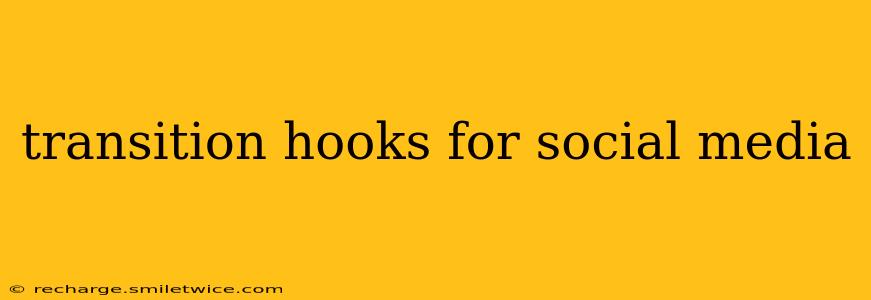Transition Hooks for Social Media: Keeping Your Audience Engaged
Social media thrives on engagement. Keeping your audience hooked requires more than just posting great content; it demands seamless transitions between topics, posts, and even platforms. This means employing effective transition hooks that maintain momentum and prevent your feed from feeling disjointed. Let's explore various strategies for creating compelling transition hooks that will keep your followers coming back for more.
What are Transition Hooks?
Transition hooks are short, impactful phrases or sentences used to bridge the gap between different topics or themes in your social media content. They provide context, maintain a narrative flow, and most importantly, keep your audience engaged. Think of them as the glue that holds your social media presence together.
Types of Transition Hooks and Examples
1. Continuing the Conversation: This style directly references the previous post or conversation, creating a sense of continuity.
- Example: "Following up on yesterday's discussion about sustainable living, let's dive into practical tips for reducing your carbon footprint!"
2. Question-Based Transitions: Engaging your audience with a question encourages interaction and creates a natural segue into a new topic.
- Example: "We've covered the benefits of regular exercise. Now, I want to know: What's your favorite way to stay active?"
3. Teaser Transitions: These hooks create anticipation and intrigue, subtly leading into a new piece of content.
- Example: "Ready to uncover the secret to [topic]? Stay tuned for my next post!"
4. Storytelling Transitions: Linking new content to an ongoing narrative strengthens engagement by building anticipation and a sense of community.
- Example: "Continuing our journey through [location/process], today we're exploring [new aspect]."
5. Visual Transitions: Using images or videos that visually link different posts creates a strong cohesive flow, even without explicit textual connections.
- Example: Using a similar color scheme or visual motif across multiple posts.
How to Choose the Right Transition Hook
The best transition hook depends on your content, your audience, and your overall brand voice. Consider:
- Your Audience: What type of language resonates best with them? Are they more receptive to formal or informal transitions?
- Your Content: What is the relationship between the previous and current post? Is it a continuation, a contrast, or a completely new topic?
- Your Brand Voice: Maintain consistency in tone and style to ensure a cohesive and professional brand image.
Common Mistakes to Avoid
- Abrupt transitions: Avoid jumping from one topic to another without any connection. This can confuse and disengage your audience.
- Overusing the same hooks: Variety is key! Employing different types of transition hooks keeps your content feeling fresh and engaging.
- Ignoring context: Make sure your transitions are relevant to your previous posts and align with your overall social media strategy.
Frequently Asked Questions (FAQ)
What is the best way to measure the effectiveness of my transition hooks? Monitor your engagement metrics (likes, comments, shares, clicks) to see how your audience responds to different transition strategies. Experiment with various approaches and analyze the results.
How often should I use transition hooks? Use them consistently, but not excessively. A well-placed transition hook is more effective than using them frequently and superfluously.
Can I use transition hooks across different social media platforms? Yes! However, remember to adapt your language and style to suit each platform's unique characteristics and audience.
By mastering the art of transition hooks, you can significantly enhance the engagement and overall effectiveness of your social media strategy. Remember that consistency, relevance, and a touch of creativity are key to crafting transition hooks that truly resonate with your audience.
